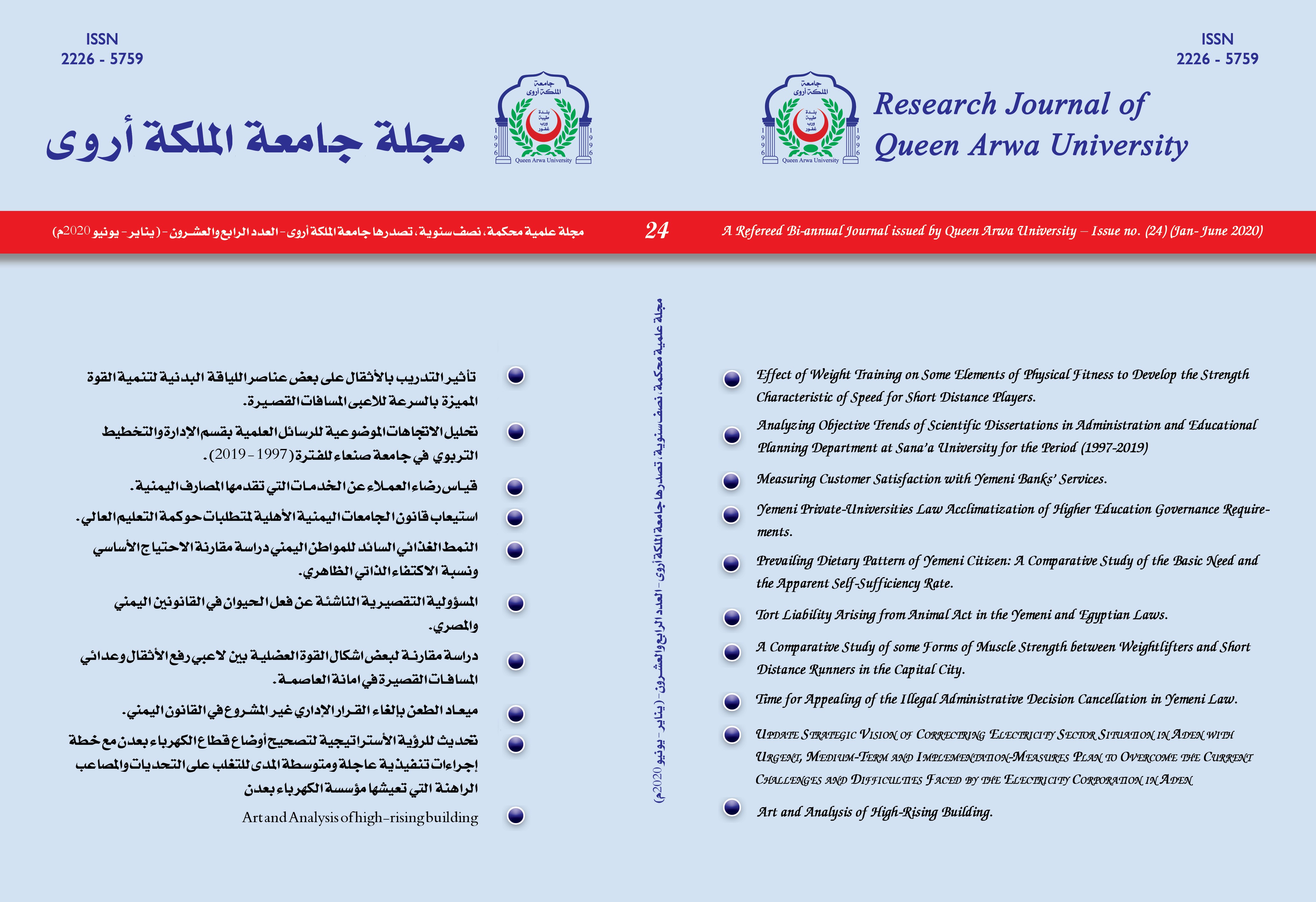The prevailing dietary pattern of the Yemeni citizen
Study comparing basic need and the percentage of apparent self-sufficiency
DOI:
https://doi.org/10.58963/qausrj.v1i24.110Keywords:
Dietary pattern , Yemeni food , DietsAbstract
The study and research aimed at analyzing the percentage of self-sufficiency through the use of modern criteria through which the size of the nutritional gap of different foods is determined at the national level of the Yemeni society using the concept of the necessary human needs of food as defined by the Food and Agriculture Organization and the World Health Organization.
The results of the analysis of the diet of the Yemeni citizen show that it is characterized by nutritional imbalance, as the individual daily gets an insufficient amount of energy that does not exceed 1964 calories / day, which is equivalent to 50% of what the individual gets in developed countries, and it is equivalent to only 7.1% of what is recommended. By the World Health Organization (WHO) and the Food and Agriculture Organization (FAO).
Also, 92% of energy sources come from plant sources, and the rest is obtained from animal sources, as the per capita share of animal protein decreases to 41 kg today. .
And by calculating the percentage of food self-sufficiency based on the concept of the necessary food needs of the individual, which was defined by the World Health Organization (WHO), instead of the concept of food available for consumption (domestic production + exports + losses) + imports + stocks.
According to the data of 2017, which confirmed the existence of a large difference in estimating the size of the food gap according to both concepts, and the concept of necessary needs showed the following:
1) There is a food group in which there is an absolute excess, which is leafy vegetables.
2) The local production of grain is not sufficient for the necessary food requirements
3) There is a food group with a relative deficit, including beans, meat and dairy.
The results indicated that the continuation of the internal conflict and the military intervention by the Saudi-led coalition countries and seventeen countries led to an exacerbation of the food crisis in Yemen, as its results led to an increase in the levels of that crisis, exacerbation of hunger and food poverty, which reached about 20 million people, to the point of famine that spread. In various parts of Yemen, north, south, east, and west, the number of internally displaced persons reached 2.57 million, 41% of whom are in childhood, and about 21.2 million people need emergency food assistance, and about 19.4 million people suffer from a severe shortage of access to water, reference No. (14). )
All of the above is undoubtedly reflected in all aspects of economic and social life and calls for the need to comply with war and delinquency to peace and acceptance of the principle of coexistence between all factions and parties with the importance of working through consultation and consultation as an important basis in the principle of peaceful exchange of power and division of wealth and the revival of justice and equality among all Yemeni citizens in rights and duties tasks and responsibilities.
Downloads
References
الجهاز المركزي للإحصاء – كتاب الاحصاء السنوي للعام، اعوام مختلفة
حسين عبد الوهاب – دراسة لمدي إمكانية تطوير النمط الاستهلاكي للطعم في مصر – كلية لزراعة – جامعة عين شمس القاهرة نوفمبر 1981م.
على محمد هدهود وآخرون – الملامح الكمية والاقتصادية لمشكلة سوء التغذية في مصر – جامعة القاهرة– 1992.
فوزي حليم رزق – النمط الغذائي المصر ومكانته بالنمط الصحي العالمي مصر المعاصرة العدد 420 – ابريل 1990م.
فوزي حليم رزق – الطلب على السلع الغذائية والتموينية – الندوة القومية للسياسات الزراعية في مصر – وزارة الزراعة – القاهرة 1992م.
محمد دويد واخرون – استراتيجيات الاعتماد على الذات – منشأه المعارف – الإسكندرية 1980 م.
محمد سعودي – وسيم علد الحميد – السكان والغذاء في مصر – كتاب الاهرام الاقتصادي، العدد 79-القاهرة 1994م.
محمد مدحت مصطفى-ازمة الغذاء العربي والمتغيرات الاقتصادية الدولية – المؤتمر الثاني لتنظيم ادارة قطاع الزراعة مصر-الجزءالأول-جامعة المنوفية –ابريل-1987م.
محمد مدحت مصطفى – الفجوة الغذائية والاكتفاء الذاتي – سلسلة كراسات تحوتي – جماعة تحوتي للدراسات المصرية –الاسكندرية-ديسمبر 1994م.
معهد بحوث الاقتصاد الزراعي –الأدارة العامة للاقتصاد الغذائي – الميزان الغذائي – مصر القاهرة 1992م.
محمد علي عوض الحرازي، (دكتور) الأثار الاقتصادية للتدخل العسكري لدول التحالف في اليمن وانعكاساتها على الوضع الانساني – المؤتمر العلمي الأول لأكاديمية الشرطة-التكييف القانوني للتدخل العسكري لدول التحالف وانتهاكاتها للقانون الدولي الإنساني في اليمن – صنعاء 21مايو2017م.
Downloads
Published
Issue
Section
Categories
License
Copyright (c) 2020 the Author(s).

This work is licensed under a Creative Commons Attribution 4.0 International License.












